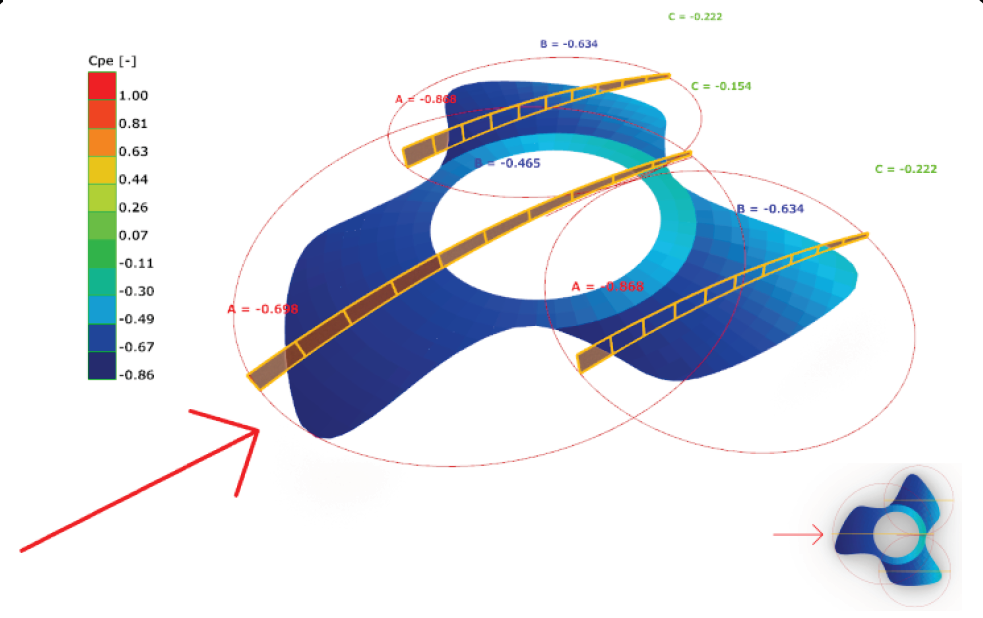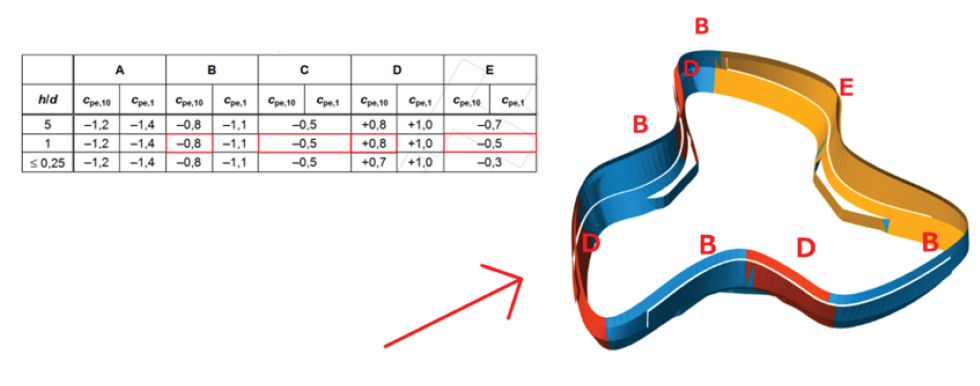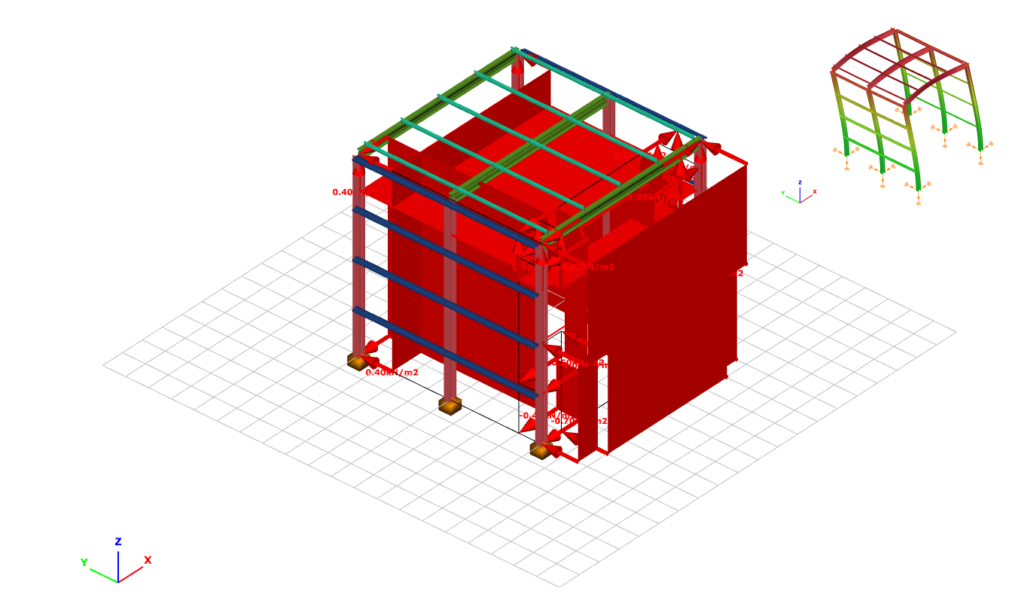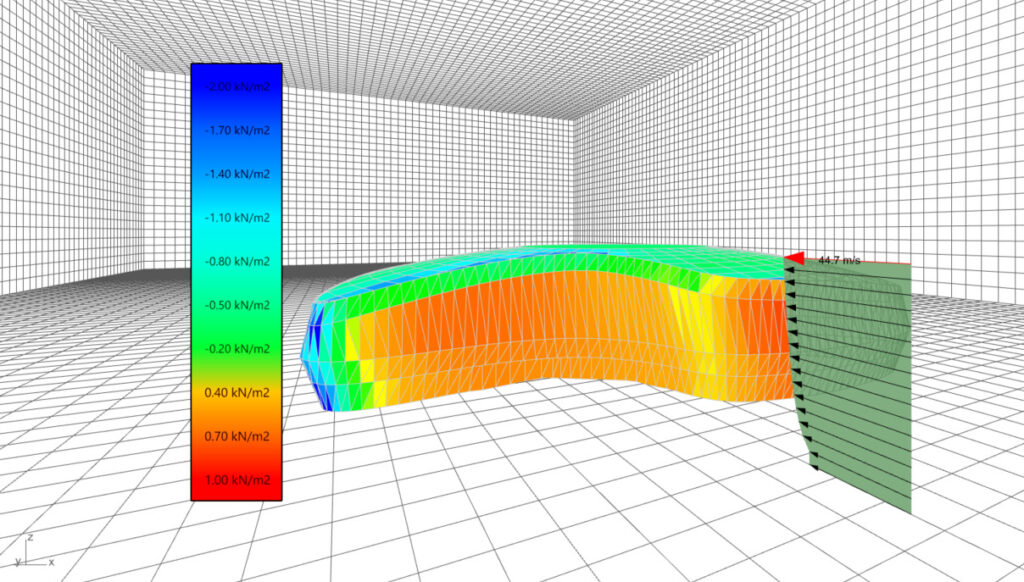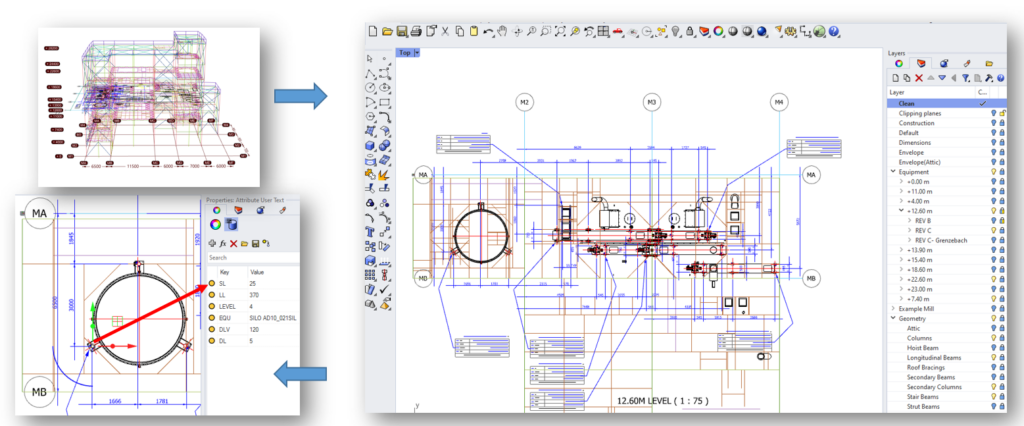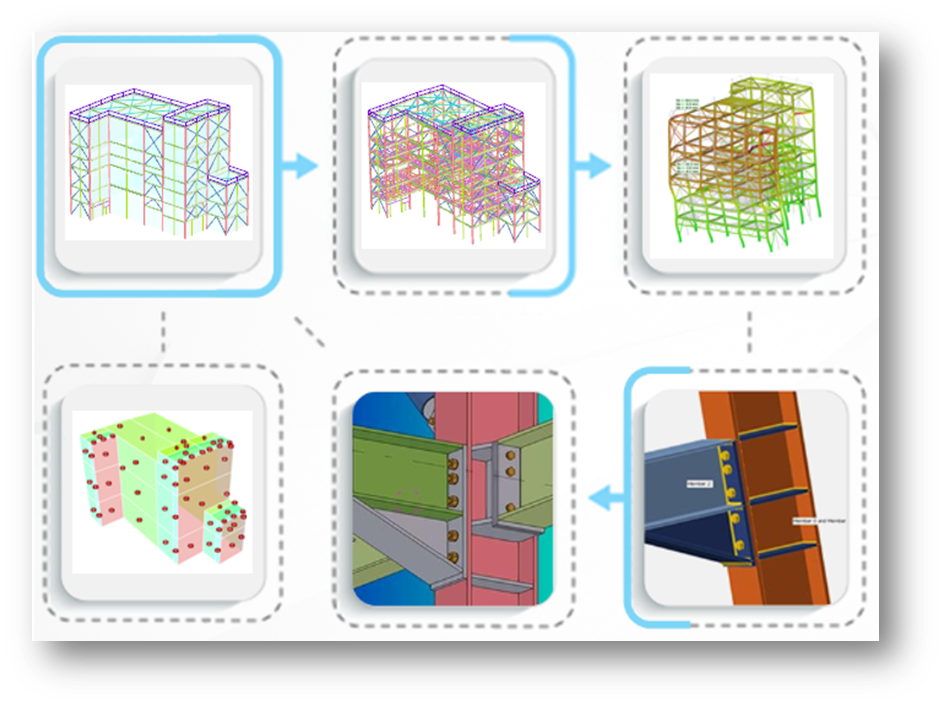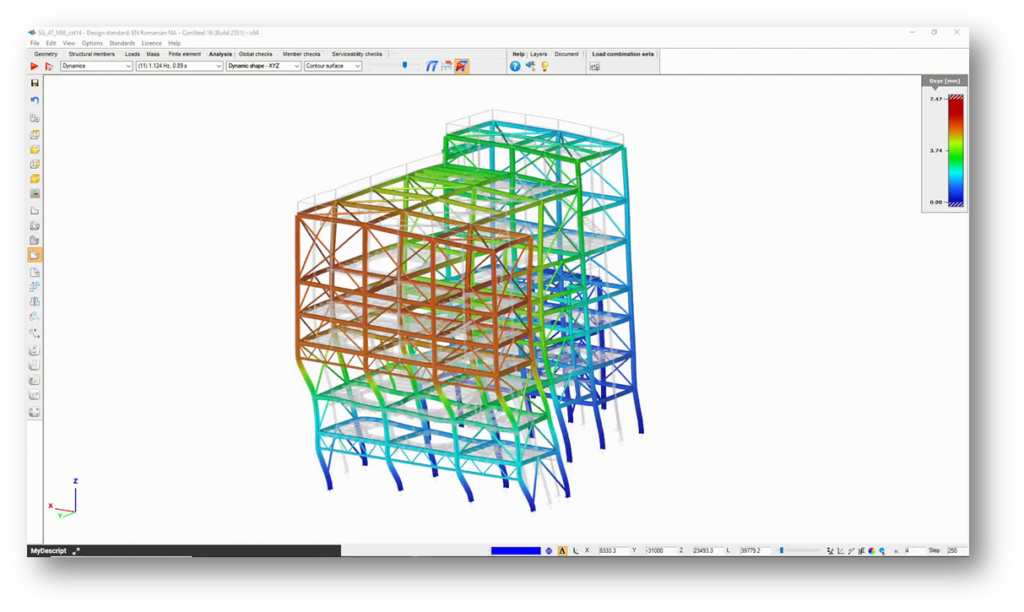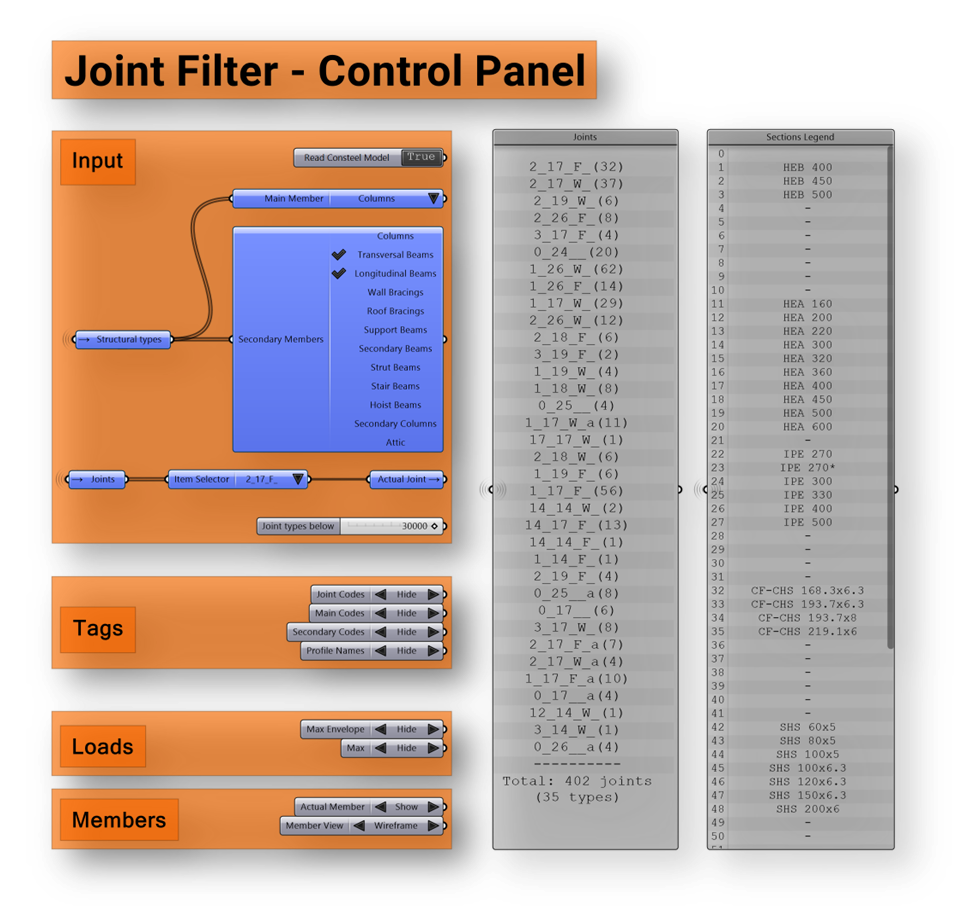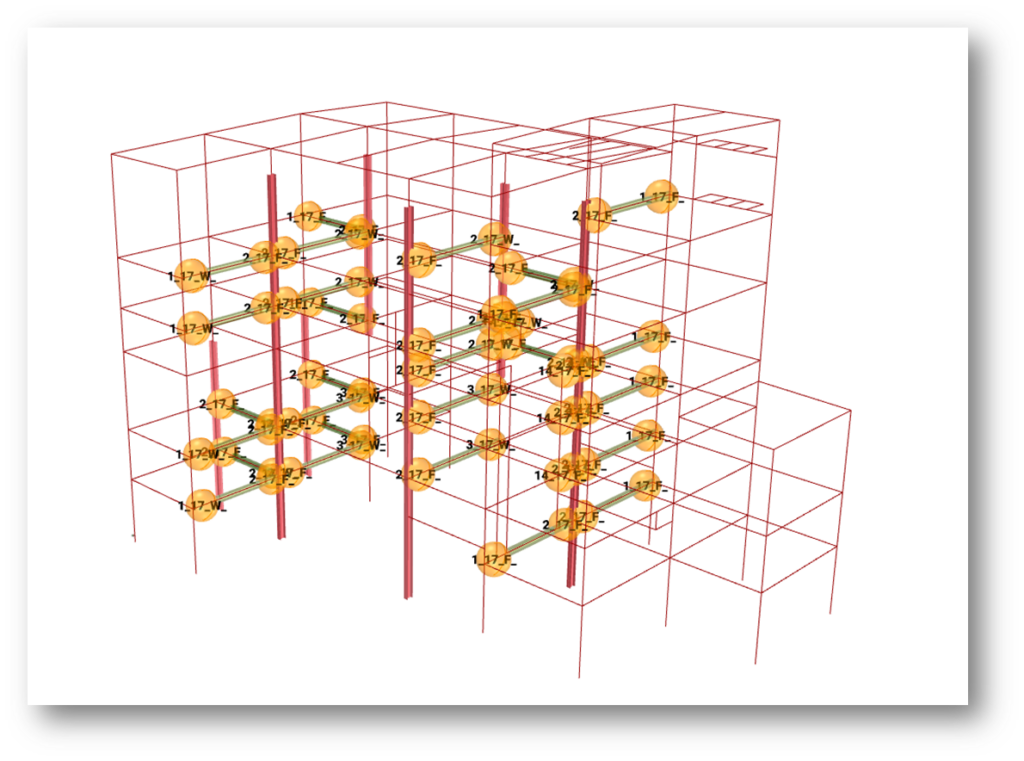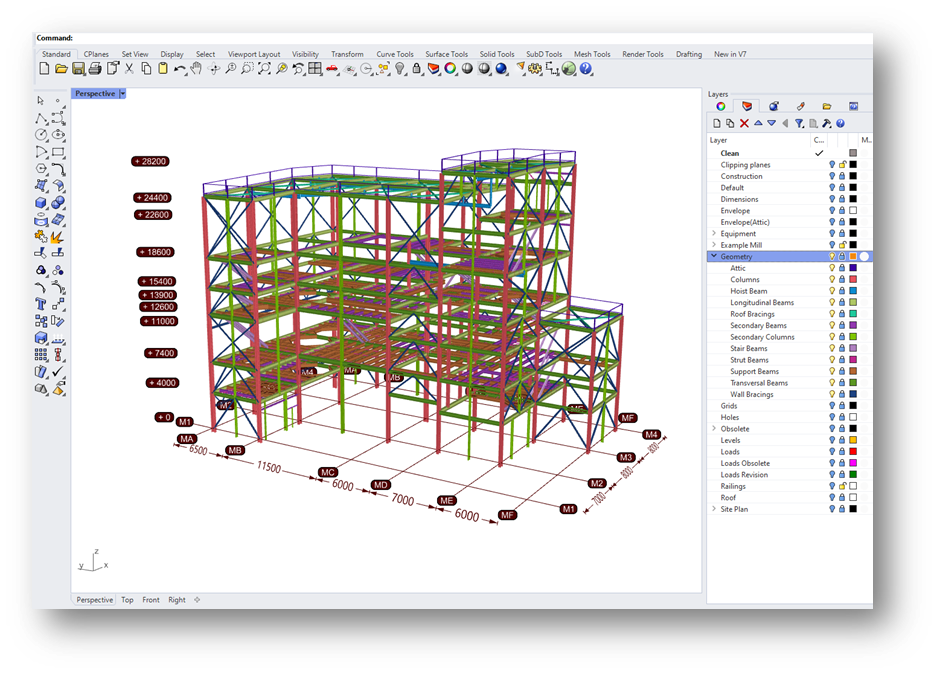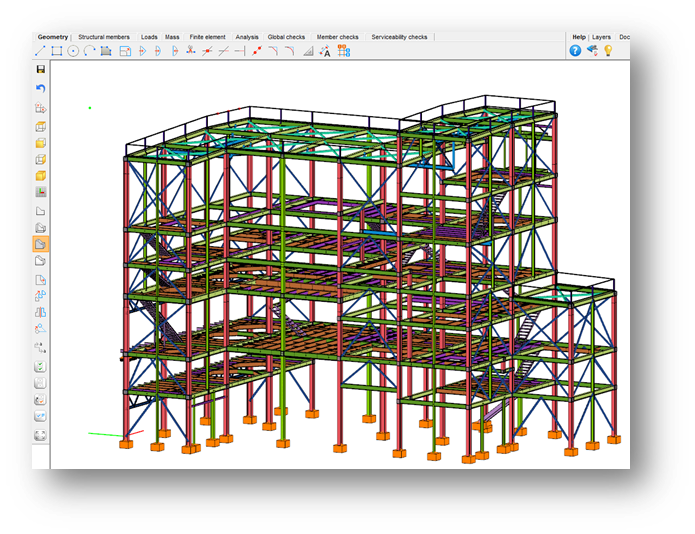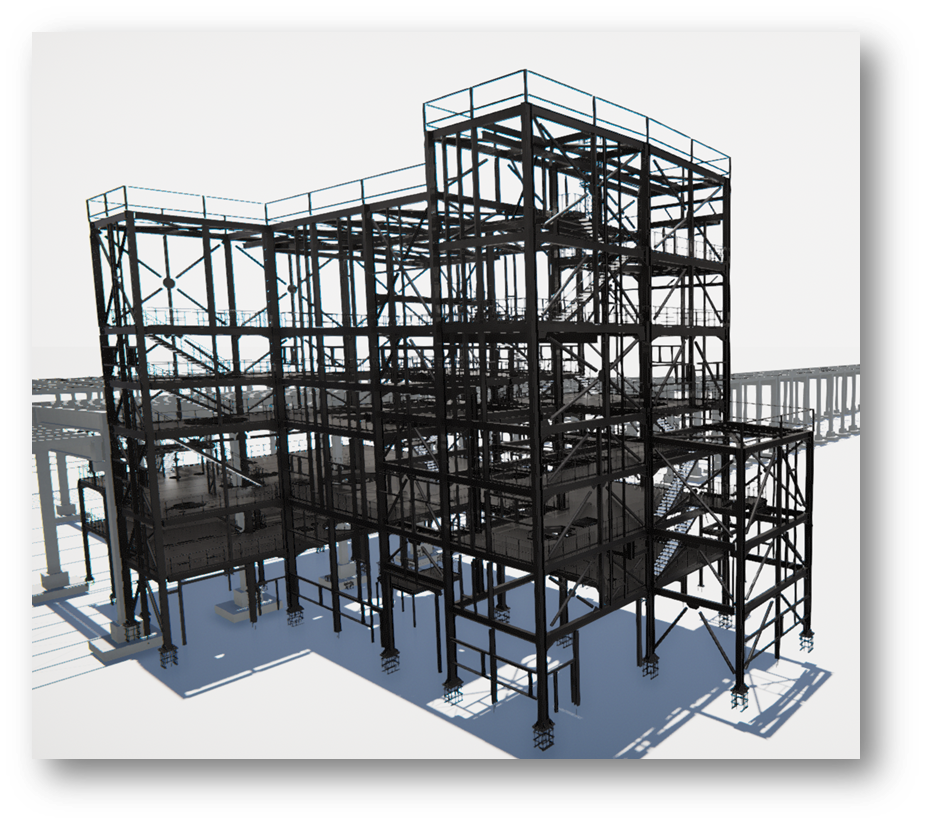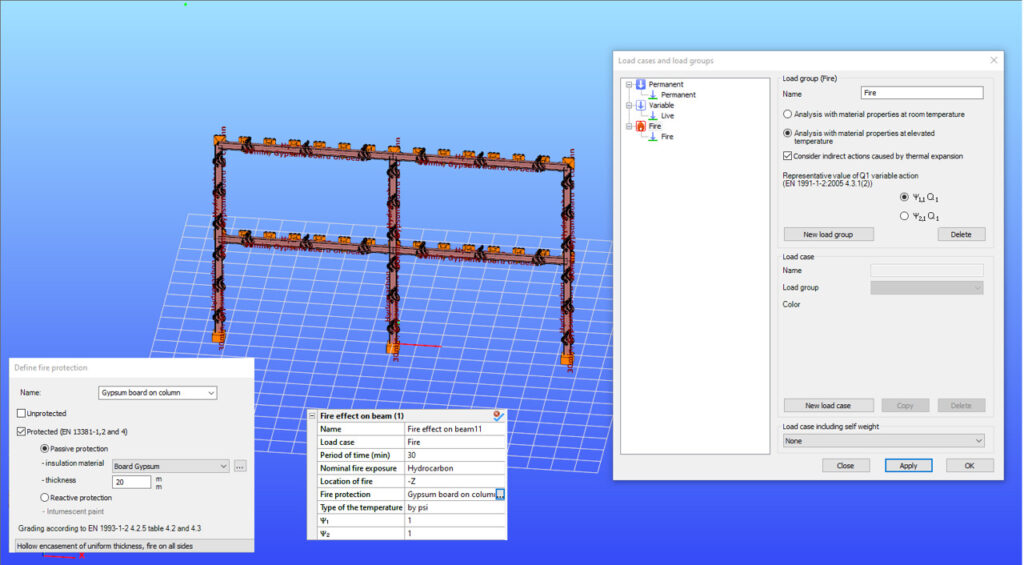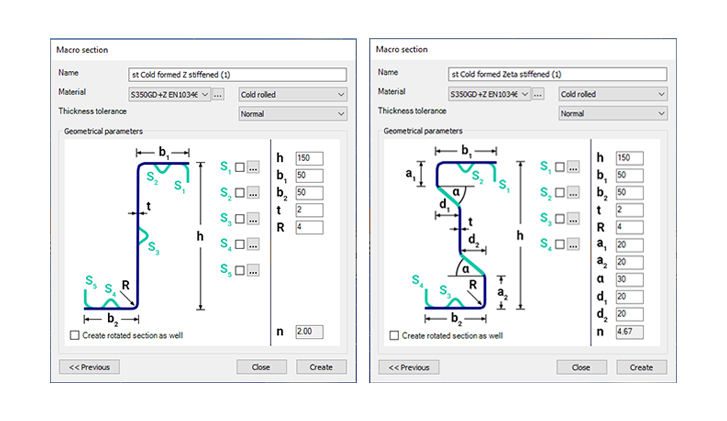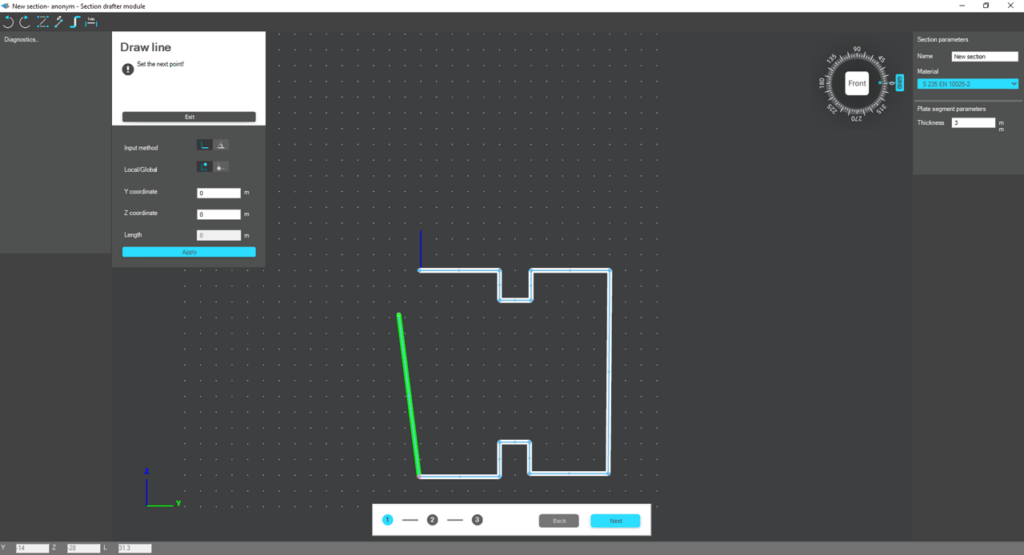Minden évben különböző stratégiák befolyásolják a Consteel funkcióinak fejlesztését. 2023-ban elsődlegesen egy központi témakörre, a szoftver használatának megkönnyítésére összpontosítottunk. Ennek megfelelően a legtöbb új fejlesztésünk a használhatóság javítását célozza a szoftver több területén. Az újdonságok között olyan praktikus funkciókat találunk, melyek a hatékony modell használatot, könnyű módosíthatóságot és világos adatszolgáltatást segítik elő mind a Consteel-ben, mind Descript-ben és felhőalapú platformunkon, a Steelspace-en is. Az új funkciókat az alábbiakban foglaltuk össze.
Automata részletmodellek
A meglévő részletmodell funkció egy könnyű megoldás nagyobb modellek kezeléséhez, melyet minden ügyfelünk használ évek óta a mindennapi folyamatok során. Ezen részletmodellek tanulmányozása során világossá vált, hogy vannak olyan kategóriák, melyeket sokan gyakran használnak a szerkezeti modellek részleteihez. Erre építve kifejlesztettünk egy új, automata részletmodell funkciót a korábbi mellé. Az elemek automatán kerülnek csoportosításra részletmodellekben szelvényük, anyagminőségük, térbeli elhelyezkedésük és legnagyobb kihasználtságuk alapján rúdelemek, valamint vastagságuk, anyagminőségük és elhelyezkedésük alapján lemezelemek esetén. Az automata részletek mindig frissülnek a modell állapotának megfelelően és a kézi részletekkel együtt is használhatóak.
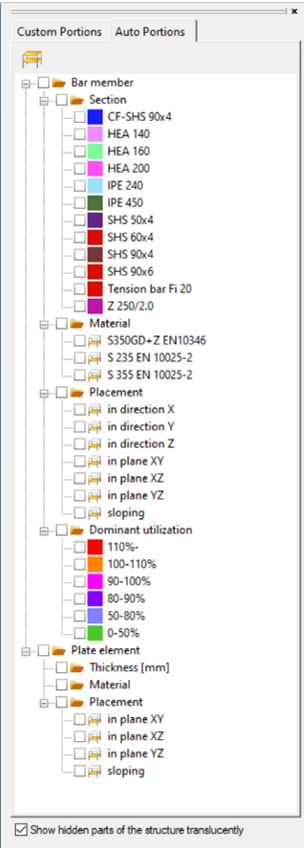
X Brace elemek
A húzott rudakat általában merevítés céljára használják és X alakban helyezik el párosával. Ezen párok speciális nemlineáris viselkedése problémákat okozhat a lineáris számításokban (elsőrendű, lineáris kihajlási analízis vagy rezgésszámítás), míg más analízis típusokban valamilyen nemlineáris megoldási technikával kezelhetők. Az új fejlesztés segítségével a felhasználó X Brace típusú végeselem típust állíthat be ezeknek az elemeknek, ami a problémás analízis típusokat a szokásos linearizációs technikával kezeli és automatikusan kihagyja az elemeket a másodrendű geometriai mátrixból.
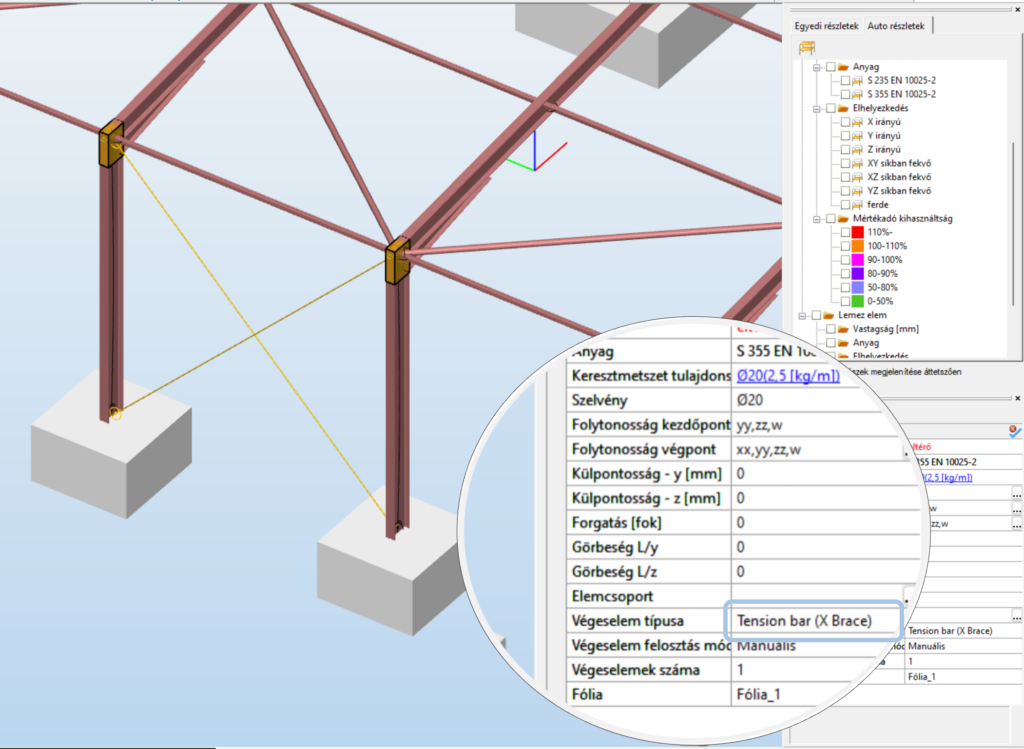
Teherátadó felületek továbbfejlesztése
A teherátadó felületek használata könnyű és hatékony módja a felületi terhek rúdelemkre osztásának. Mivel azonban a szétosztásnak nincs mechanikai háttere, nem mindig hozza azt a megoldást, amit várnánk (például nem tudja figyelembevenni a felület merevségét). Ezen probléma kezelésének érdekében módosítottuk a teherátadó felület alapvető működését, melynek eredményeképp a felhasználó immár módosíthatja a keletkező vonalmenti terhek valamennyi paraméterét miután leválasztotta a felületi teherről. Az automata frissítés vagyis a vonalmenti terhek újragenerálásának folyamata is szabályozható a felhasználó által.
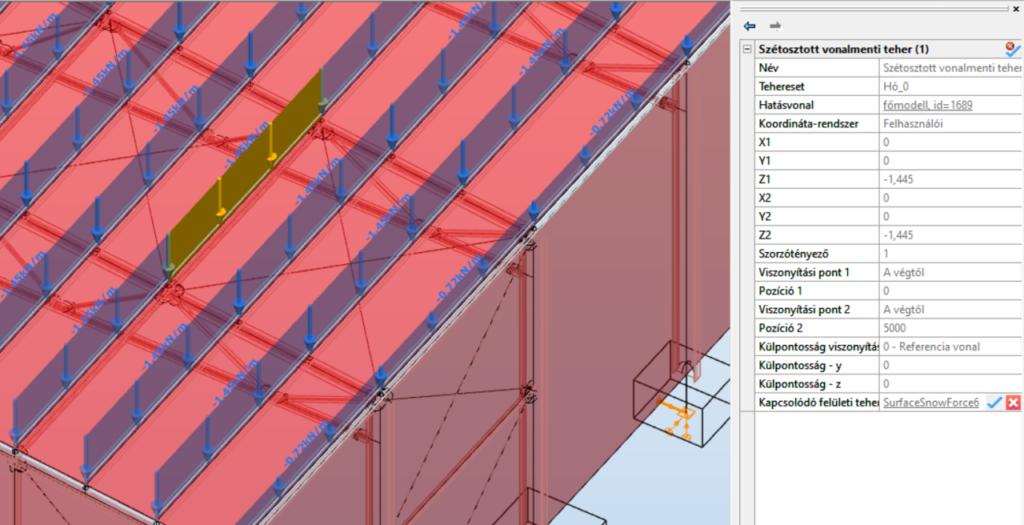
Kiterjesztett és egyesített tervezési eredmények
Időnként csak a számítási eredmények gyors áttekintése szükséges, míg más helyzetek részletes vizsgálatokat igényelnek. Mindkét kívánalom kielégítésének érdekében átdolgoztuk a tervezési eredmények kezelését és megjelenítését. Egyrészt összevontuk az ULS és SLS vizsgáltok végrehajtását és eredményeik kijelzését. Ennek megfelelően a mértékadó tervezési eredmények közvetlenül elérhetők az összes határállapot figyelembevételével. Másrészt, az összes számolt teherkombinációból származó minden kihasználtság elmentésre kerül és megjeleníthető, ha a szerkezet megfelelőségének részletes vizsgálatára van szükség.
Szoftver interakciók új környezetben
A szoftverek közötti kapcsolatok lehetőségei iránti egyre növekvő igényre reagálva egy új koncepciót fejlesztettünk ki, mely az összes interfészünk alapjául fog szolgálni. Ez az SDK-alapú környezet megteremti annak a lehetőségét, hogy a külső modelleket egy általános formátumra (smadsteel) konvertáljunk, amely mind a Consteellel, mind a Steelspace-szel kompatibilis. Ezen módszertan szerinti utunkon az első lépés az Axis VM statikai számító szoftverbe beépülő bővítmény fejlesztése. Ennek segítségével az Axis VM modellek smadsteel formátumba konvertálódnak, majd ezután Consteel-ben megnyithatók. A konverzió nem csak geometriai és szelvény adatokra, hanem mechanikai objektumokra (támaszok, kényszerek stb.), terhekre és teherkombinációkra is kiterjed. A környezet lehetőséget teremtett különböző szintű szelvény és anyag konverzióra, valamint az folyamat sikerességéről szóló átfogó dokumentáció elkészítésére, mely magában foglalja a problémás modellobjektumok vizualizációját is.
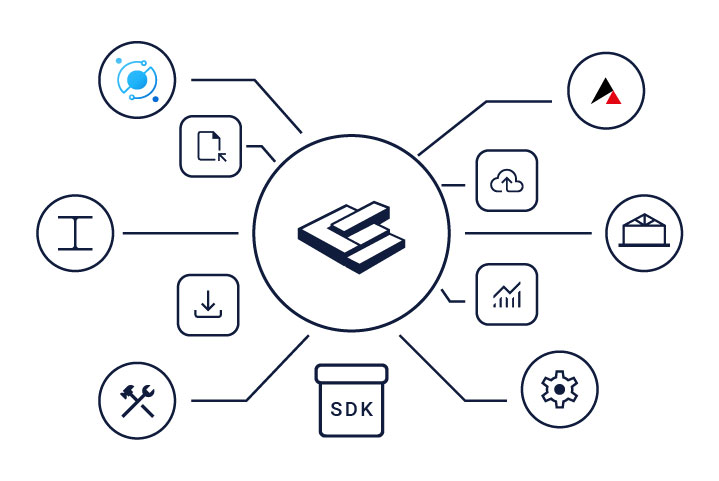
Descript fejlesztések
Mivel a beépített szkriptnyelvünket, a Descriptet egyre gyakrabban használjátok, az új fejlesztések iránti igények folyamatosan felmerülnek a különböző területeken történő alkalmazások nyomán. Ezen igények általában új elemeket vagy szkript nyelv fejlesztéseket jelentenek a szükséges funkciók lefedésére. Az újdonságok között vannak új parancsok, például egyedi hidegen alakított keresztmetszet létrehozása vagy objektumhivatkozási lekérdezések; valamint az objektum létrehozás, kezelés és lekérdezés kiterjesztett lehetőségei. Mindezeket arra terveztük, hogy páratlan sokoldalúsággal és hatékonysággal ruházzák fel a szerkezettervezési projektjeidet.
Hatékony modellezést segítő fejlesztések (felhasználói kérések)
Felhasználóinktól érkező közvetlen kérésekre reagálva ebben a verzióban több, a Consteel használhatóságát tovább növelő fejlesztést is végrehajtottunk:
- kiválasztott elemek elrejtése
- másolás és mozgatás funkció szétválasztása
- anyagminőség módosítása egyszerre több acélszelvényre
- rúdelemeken színezett kezdő és végpontok
- gyors kiválasztás tulajdonság alapján duplaklikkel az objektum tulajdonság ablakban
- szerkezeti elem kijelölése analízis vagy szabványos tervezési eredmény táblázatból
Részletes modellösszehasonlítás
Egy modell számos módosításon megy keresztül a tervezési folyamat során. A korábbi Consteel újításoknak köszönhetően a változtatásokhoz kapcsolódó fontos mérföldköveket, döntési pontokat már verziók formájában is megőrizhetjük a modell verzióelőzmények funkcióval. Erre alapozva fejlesztettük tovább a modell előzményeiben történő verziók összehasonlításának lehetőségét. Az új funkció lehetőséget nyújt a felhasználónak, hogy testre szabja az összehasonlítási folyamatot, kizárólag az adott tervezési szakaszban releváns objektumokra és attribútumokra összpontosítva. Az összehasonlítási eredmények látványosan mutatják a paraméter különbségeket, kiemelve a fontosnak jelölt objektumokat és attribútumokat. A felhasználói felület elemei közül a kiválasztás fül és az objektumtulajdonságok megjelenítője átdolgozásra kerültek annak érdekében, hogy az összehasonlításkor mindkét verzióban található adatok különbségei könnyen hozzáférhetővé váljanak.
Elérhető a Metszősík funkció a Steelspace-ben!
Tudj meg többet a saját modelledről! A Consteel felhőalapú modell megtekintőjének, a Steelspace-nek legújabb frissítésének részeként bevezetjük a metszősík funkciót. A fejlesztés lehetővé teszi, hogy létrehozz egy metszősík objektumot, ami egy síkot képvisel, és levágja az adott nézetablakban található geometriai elemeket.
Továbbfejlesztett együttműködési lehetőségek
Az eredményes együttműködés gyakran kulcsfontosságú a munka felgyorsításához, különösen a nagyobb projektek szerkezeti tervezési fázisában. Ezt felismerve lépéseket tettünk az együttműködés javítása érdekében, és továbbfejlesztettük a Consteel modell verzióelőzmények funkcióját. Újításunkkal már lehetőség van van több mérnöknek vagy csapattagnak különböző jogosultsági szintekkel testreszabott hozzáférést biztosítani a modellhez. Ebben az esetben több mérnök is menthet új verziókat ugyanazon projekt verzióelőzményébe, ahol a verziók már a készítőjét is tartalmazzák.
Nézd meg az összefoglaló videónkat
Fedezd fel az új funkciókat ingyenesen
Töltsd le az új verziót most!
LetöltésHa még ismeretlen számodra a Consteel, könnyedén felfedezheted az új funkciókat. A Consteel 17 kiadása után az új fejlesztések automatikusan elérhetővé válnak az ingyenes próbaverzióban.
Azok a felhasználóink, akik online védelemmel használják szoftverünket, a telepítés után automatikusan hozzáférnek a legújabb verzióhoz. Az USB dongle védelemmel rendelkező Consteel-felhasználókat az új verzió megjelenésekor értesítjük a frissítéshez szükséges információkkal. A frissítéssel kapcsolatos bármilyen probléma esetén kérjük fordulj ügyfélszolgálatunkhoz.
A hagyományos tervezés, a különböző szabványok figyelembevétele / alkalmazása esetén rengeteg, empirikus úton bevezetett biztonsági tényezők és statisztikai megközelítések használatán alapul. Ennek következtében gyakran a vizsgálandó épületek geometriai kialakítása, illetve a rá ható terhek jelentős szinten változhatnak az egyszerűsítések következtében kiváltképp, ha a szerkezet geometriája szabadformájú, melyet a szokásos eszköztárral gyakorlatilag lehetetlen pontosan modellezni és ezáltal elemezni.
A valóságtól való elrugaszkodás jogos aggodalmat okozhat egy szerkezettervező számára, főleg ha szélteher meghatározásáról van szó. Mérnökileg megfontoltan, de tudni kell reagálni a modern kor építészeti igényeire is. Ezért a szabványok által kínált konzervatív megoldások és a szélcsatorna vizsgálatok mellett egyre inkább teret hódítanak a numerikus folyadékdinamikai szimulációs módszerek (CFD – Computational Fluid Dynamics), mivel megoldást nyújtanak nem szokványos geometriák okozta kihívásokra. Erre a célra az OpenFOAM , mint CFD motor megoldások széles skáláját kínálja. Azonban egy ilyen szimulációhoz elengedhetetlen a megfelelő környezet, ahol könnyen meghatározható az összes szükséges paraméter egy szimulációs vizsgálat beállításához. Ez vezetett ahhoz, hogy a saját, a témában végzett kutatások alapján megkezdjük az implementálást a saját platformjainkon, egy új funkcionalitást fejlesztve. Ezáltal lehetővé válik, hogy a szimulációs paramétereket rendkívűl kényelmes módon meg lehessen adni, így az OpenFOAM átfogó ismerete nem szükséges, a háttérben, mint számítómotor működik majd.
Szabvány értelmezések a szabad formájú szerkezetek esetében
A szerkezetre ható szél erőssége a szél átlagos sebességéből és az épületet körülvevő áramlási közegben, a szél hatására fellépő turbulencia által generált fluktuáló szélerősség alapján számítható. Az EN-1991-1-4 szabvány a tartószerkezeteket érő szélhatások számításához a szél által generált igénybevételeket egyszerűsített felületi nyomásokként határozza meg, figyelembe véve a szerkezet alakját, elhelyezkedését, a terep egyenetlenségét …stb. Ezáltal a szélhatás egy kvázi-statikus hatásként vehető figyelembe, mely megegyezik a turbulens szél maximális sebességének hatásával. Azaz a felületi nyomás (vagy szívás) a torlónyomás csúcsértékének („z” magasságban a talaj felett) és az épülethez tartozó alaki tényezők – melyet a szabvány csak bizonyos szabályos formák esetén tárgyal: lapostetők, nyeregtetők, kupolák stb. – szorzatának eredményeképpen határozható meg.
Például az alábbi szabad formájú szerkezet esetében a külső nyomástényezőknek a meghatározása komoly kihívást jelenthet. Mindenekelőtt a szerkezet viszonylag alacsony tetőhajlásszöge miatt nehéz eldönteni, hogy a tetőt íves ereszű lapostetőnek, vagy kupolának tekintsük (mivel egy gömb felületéhez illeszkedik). A kupola esetében a szabvány viszonylag körülményesen 3 karakterisztikus értéket ad meg az épület ereszmagasságától, tetőmagasságától és átmérőjétől függően. Ezeknek az értékeknek az adott geometriára való alkalmazása erősen vitatható, különösen az élek mentén.
Similar questions are raised if we try to apply the pressure coefficients on walls which are not regular.
CFD szimulációk
A numerikus folyadékdinamika (CFD – Computational Fluid Dynamics) a folyadékmechanika egyik ága, amely a folyadékáramlás és a hőátadás jelenségeinek numerikus szimulációjával és elemzésével foglalkozik. A CFD magában foglalja a számítógépes algoritmusok és numerikus módszerek alkalmazását az áramlást leíró egyenleteknek, például a Navier-Stokes-egyenleteknek a megoldására egy végeselem-térfogatokat tartalmazó diszkretizált tartományon. Ezekre a problémákra az OpenFOAM, mint eszközkészlet az egyik legalkalmasabb.
Az OpenFOAM számos alkalmazást tartalmaz, amelyek két fő típusra oszthatók. A “Solver” típusú alkalmazások speciális szilárd vagy folyékony test mechanikai problémák megoldására alkalmasak, míg a “Utility” típusúak háló létrehozására és adatkezelésre használhatóak.
Egy CFD alapú szimuláció előkészítéséhez az alábbi fő lépéseket különíthetjük el:
- Egy előzetes háló generálásának folyamatai, egy a szimuláció és a teherfelvétel szempontjából megfelelő model létrehozása érdekében
- Bemeneti paraméterek megadása (a torlónyomás csúcsértékének megfelelő szélsebesség v
p(z), szélirány, érdességi hossz z0, az áramlási közeg geometriai peremfeltételei stb.)
- véges térfogatelem alapú háló generálása az OpenFOAM által
- Turbulencia modell és megoldóalgoritmus kiválasztása
A fejlesztés jelenlegi szakasza egy bizonyos turbulenciamodell használatán alapszik, amely a kinetikus energia és az energiaeloszlás differenciálegyenleteit kezeli (k-ε modell), a simpleFoam megoldóval (SIMPLE = Semi – Implicit Method for Pressure Linked Equations) együtt . Ebben az esetben a szimuláció a következő feltételeket feltételezi:
- Összenyomhatatlan, merev testek
- Turbulens áramlás
- Nincs fizikai idő, kvázi statikus nyomás
A mi szolgáltatásunk,mint egy általános munkafolyamat a szélteher meghatározásához
A fent azonosított lépéseknek megfelelően megkezdtük egy olyan szolgáltatás fejlesztését, amely a lehető legautomatikusabban készít előhálót a terhelés hozzárendeléséhez és előkészíti a szükséges adatokat az OpenFOAM számára, amely véges térfogatú hálót generál (előfeldolgozási szakasz) és szimulációt végez (adatfeldolgozási szakasz) a lenti ábrákhoz hasonlóan. Ehhez a felhasználónak a geometriai és hálógenerálási paramétereken kívül, mint például a kívánt terhek cellamérete és a hálófinomítás csak a szél referencia alapsebességét, irányát és a terepkategóriát kell megadnia a szélprofil meghatározásához a szerkezettervezői logikának megfelelően (elsősorban az Eurocode-ban szereplő szélprofilhoz hasonlóan).
A jelenlegi fejlesztés egy további és egyben a fő funkciót (utófeldolgozási szakasz) célozza meg, amely a kapott nyomásértékekből a felhasználói preferenciáknak megfelelően automatikus konvertálást kínál használható felületi terhekké. Lehetséges lesz a szimulációs eredmények közvetlen hozzárendelése az előhálóhoz, vagy akár egy, a szabványhoz hasonló zónázási logika alkalmazása.
Összességében komoly potenciál rejlik a funkcióban, elsősorban a sokoldalúsága miatt. A tapasztalat azonban azt mutatja, hogy bár a CFD szimuláció során kinyert szélterhek eredményei használhatóak ipari felhasználásra, helyessége nagymértékben függ a bemeneti paraméterek minőségétől. Minimális folyadékdinamikai szakértelem tehát még szükséges, de a fejlesztés jelenlegi állása már megoldást kínál a szerkezetmérnökök számára, hogy ezeket a szimulációkat viszonylag könnyen elvégezhessék. A szolgáltatást több csatornán is tervezzük implementálni a meglévő platformjainkon: Consteel (közvetlen asztali használat Consteel modelleken), Steelspace (felhő alapú használat kompatibilis modelleken) és Grasshopper (bármilyen GH környezetben definiált modellen, például Pangolinnal), hogy minél több, különböző eszközöket használó mérnök számára is elérhető legyen.
Olvasd el a romániai Tordán található gipszkartongyár bővítéséről szóló új, részletes esettanulmányunkat, amely bemutatja hogyan vezetett a bővítés kilenc új építmény építéséhez. A központi parametrikus modellt használó projekt elnyerte idén a harmadik helyet a The Steel Lion Award 2023 versenyen, köszönhetően a Consteel acélszerkezet-tervezési szoftver és a Pangolin, a Consteel Rhino-Grasshopper bővítményének innovatív alkalmazásáért.
1. Projekt információ
A projekt célja egy meglévő gipszkarton gyár bővítése Tordán (Románia), ezáltal 9 új építmény létrehozása.
Ezek az épületek több célt szolgálnak, a nyersanyagfeldolgozástól a szemét tárolásáig. A gyártási folyamatot lekövető és szolgáló épület a “malom”, mely egy többszintes merev keretszerkezetből felépített acélszerkezet. A maximális keret fesztáv 8 méter, a 7 szintes szerkezet teljes magassága 28 méter.
2. Központi parametrikus modell
Bár a szerkezet geometriája klasszikus formákon alapszik, amelyek elsőre nem feltétlen szükségeltetnek parametrikus tervezési módszereket, a célunk mégis az volt, hogy parametrizáljuk és egy központi BIM model felépítésével minden adatot egy helyen tartsunk a projekt tervezése folyamán. Ezen adatok közés sorolható: a 3D-s technológiai berendezések modelljei, az ezekről készült műszaki adatlapok és tervek, a hozzájuk tartozó permanens és hasznos terhelésekkel, az ezekhez köthető összes revízió, az építészeti tervek stb. Figyelembe véve a tehát a kapott adatszolgáltatást, itt építettük fel a geometriát, definiáltuk a tehereseteket, a terheket stb.. Az így kapott szerkezet egy kész rúdváz modell volt, melynek globál statikai analízisét a Consteel használatával végeztük.
Így a központi modell a Rhino-Grasshopper felületekről irányította a teljes tervezési folyamatot (bal felső sarok). Itt volt összehangolva a teljes teherfelvételi folyamat (bal alsó), a statikai modell építése (középső felső), a csomóponti számításokhoz szükséges modellek generálása (jobb alsó) a statikai számítások eredményei alapján (jobb felső), legvégül pedig gyakorlatilag a teljes részletezés (középső alsó).
3. Vizsgálatok a Consteelban
A tervezést érintő fő kihívást a tehnológia összehangolása a szerkezettel jelentette. Alapvetően a tehnológiai berendezések tervezése párhuzamosan zajlott a szerkezet tervezésével és a szerkezet gyakorlatilag folyamatosan alárendelt szerepet játszott, így rugalmasan kellett tudni alkalmozkodni bármilyen, a tehnológia oldaláról jövő módosításhoz. Kihasználva a Pangolin kétirányú működését, a Consteelben folyamatosan optimizált szerkezettel, gyakorlatilag azonnal frissíthettük a központi modellünk, ezáltal mindig rendelkezésre állt az aktuális állapot, így a az épület részletezése is párhuzamosan zajlott. Szintén kihívást jelentett, hogy az épület egy előregyártott vasbetonszerkezetű gyártócsarnokkal van összekötve, így az érintett homlokzat esetén az első három szinten hagyományos merevítőrendszer nem volt alkalmazható, ami nagyban befolyásolta a szerkezet globális viselkédését vízszintes terhelések esetén. Így különösen fontos volt az összes szerkezeti elem figyelembe vétele egy globális modellben, ez esetben a merevítést biztosító rácsostartókkal együtt.
4. Csomópontszűrés
A főstatikai vizsgálatok után a csomóponti statikát végeztük el a Grasshopper-IdeaStatica kompatibilitását kihasználva. Ezáltal típuscsomópontokat szűrtünk (például oszloptoldás, oszlop-főtartó), melyeket a Consteel modellből automatán kigyűjtött igénybevételekre méreteztünk. Ezek az igénybevételek a választott típuscsomópont összes pozicióját megvizsgálva a maximális egyidejű, valamint az abszolút maximum értékek voltak. A méretezett kapcsolatokat egy-egy előre elmentett Tekla makró felhasználásával, Grasshopper segítségével szórtuk ki az összes pozicióra. Így lehetséges volt a födémmerevítők 2074 csomópontjának kiszórására egy kattintás segítségével. Ezzel a módszerrel több mint 3800 Tekla makrót szórtunk ki Grasshopper vezérléssel.
5. Következtetések
A tervezés két fő fázisból állt. A koncepcionális szintű tervezés során, ami alapján végül az engedélyeztetési tervek is készültek, már elkezdtük a parametrikus, központi modellre épülő szkript írását. Erre egy belső fejlesztésként is tekintettünk, ami további, hasonló kaliberű projektek esetén is kiindulópontként funkcionál. Így amikor már a második fázis során végleges, részletterveket készítettük egy nagyon rugalmas eszköz állt rendelkezésünkre, ami egyszerre biztosított adatot a statikai ellenőrzések, a globális és csomóponti méretezések, illetve a részletezés, majd a gyártmánytervezés számára is. Ez a munkafolyamat rendkívűl hatékonynak bizonyult, gyakorlatilag mindvégig csak 1 projektirányító főstatikus és 1, a szkript fejlesztéséért és használatáért felelős statikus munkájára volt állandóan szükség, a körülbelül két éves tervezési folyamat során, az acélszerkezet szempontjából. Így amikor minden véglegesnek volt tekinthető gyakorlatilag egyszerre belehetett vonni további 5 mérnököt akikkel együtt nagyjából 2 hónap alatt a teljes csomóponti méretezés, a fennmaradó, csak manuálisan megoldható részletezés és a gyártmánytervezés lebonyolítható volt.
A honlapunkon a Letöltések menüben már elérhető egy új hardverkulcs illesztőprogram.
A honlapunkon a Letöltések menüben már elérhető egy új hardverkulcs illesztőprogram, amely a Windows 10 és 11 legújabb frissítéseivel is kompatibilis. A kulcs hibátlan működésének érdekében kérjük, töltsd le és telepítsd fel az új drivert! Csak azoknak a felhasználóknak van szükségük erre az illesztőprogramra, akik a Consteelt USB dongle védelemmel használják.
Hogyan tölthető le az új illesztőprogram?
Jelentkezz be az online fiókodba a weboldalunkon a Letöltések oldalon, és kattints az USB-illesztőprogram letöltése ikonra az illesztőprogram letöltéséhez. Ezután már csak telepíteni kell a számítógépre.
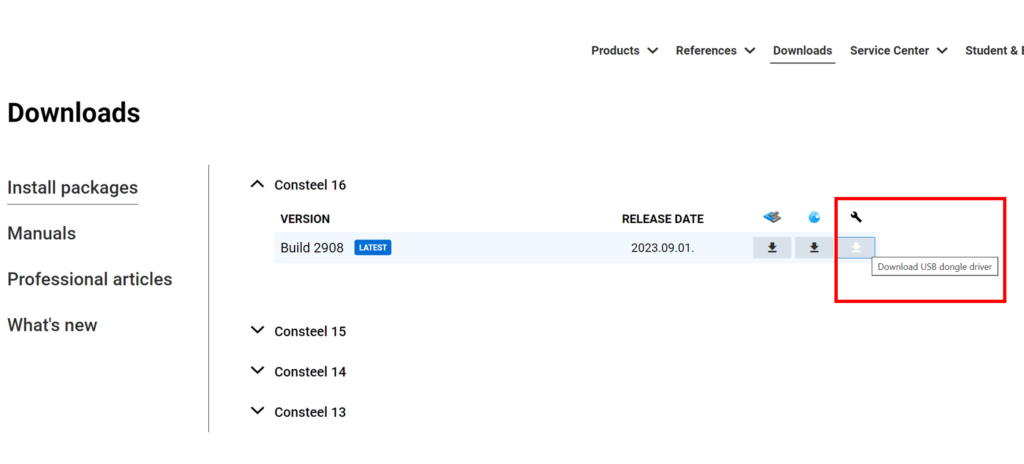
This month we have shared 4 new example models regarding fire resistance, cold-formed macro sections, user-defined cross sections, and shear stiffness. Models are available for download from the Knowledge Base.
Perform structural analysis at room and elevated temperatures as part of design process for fire resistance
Did you know that you could use Consteel to perform structural analysis at room and elevated temperatures as part of design process for fire resistance?
Include in your model a wide range of cold-formed macro sections
Did you know that you could use Consteel to include in your model a wide range of cold-formed macro sections?
Draw a user-defined cross section and calculate its section properties
Did you know that you could use Consteel to draw a user-defined cross section and calculate its section properties?
Consider the shear stiffness of a steel deck as stabilization for steel members
Did you know that you could use Consteel to consider the shear stiffness of a steel deck as stabilization for steel members?
To see what else the Consteel software can do, check out the features.
Mostantól a támogatást kérő felület a Consteel-ből közvetlenül is elérhetővé vált, így gyorsabban, egyszerűbben és kényelmesebben léphetsz kapcsolatba ügyfélszolgálati csapatunkkal. Emellett az új fejlesztés lehetővé teszi a felhasználók számára további fejlesztési javaslatok beküldését és oktatói anyagok elérését, miközben épp a szoftverrel dolgoznak. Lássuk, hogyan is működik ez az újítás a gyakorlatban!
Kibővített Súgó menü
A program felső részén található „Súgó” menüpontot különböző lehetőségekkel bővítettük a felmerült igényeknek megfelelően.
A menüt két szekcióra osztottuk, az első tartalmazza az elérhetőségeket az „Consteel kézikönyvhöz” és a „Descript kézikönyvhöz„, valamint az „Oktatói anyagok” almenüpont segítségével egy előszűrt tudásbázis anyagokat tartalmazó oldal érhető el. Ilyenkor nincs szükség külön bejelentkezésre a honlapunkon, mert a Consteel-t online védelemmel használó felhasználóinkat automatikusan felismeri az oldal.
A második szekció a támogatással kapcsolatos kéréseknek lett kialakítva. A „Support kérdés beküldése” parancs megnyitja a támogató rendszerünk bejelentő oldalát, ahol segítséget tudsz kérni a Consteel-lel kapcsolatos kérdéseidhez. Ha esetleg a licenceléssel adódna gond, akkor a „Licenceléssel kapcsolatos problémák” parancsra kell kattintanod. Számunkra fontos a véleményed, így ha valamilyen javaslatod vagy kérésed merülne fel, csak kattints a „Felhasználói kérés beküldése” parancsra és oszd meg velünk a gondolataidat.
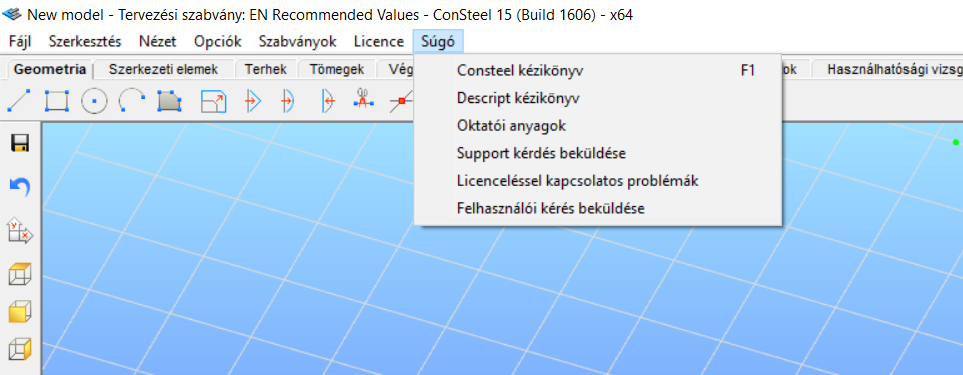
Az új „Súgó” fül
A nélkülözhetetlen támogatással kapcsolatos parancsoknak egy új „Súgó” fület is létrehoztunk, hogy a segítségkérés még könnyebben elérhető legyen a grafikus felületről.
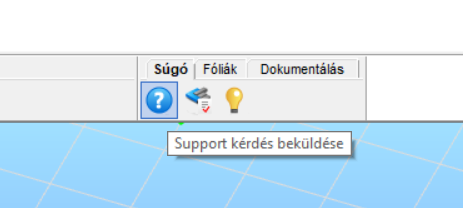
Ezek a támogató lehetőségek mostantól a Project Center bal alsó részéből szintén könnyedén megnyithatók.

Új support kérdés, licencelési probléma bejelentése vagy felhasználói kérés beküldése esetén, kérünk, adj meg minél több információt (Consteel modell, képernyőkép stb.), hogy minél hatékonyabban tudjunk neked segíteni. Fejlődjünk együtt, segíts a visszajelzéseddel!
Reméljük hasznosnak találod az új fejlesztésünket. A funkció a Pro vagy Prémium tagsággal rendelkező felhasználók számára érhető el.
A Consteel 15 megjelenésével együtt több újdonság és változás is történt, ami érinti a szoftver használatát.
Megszűnik a Consteel Joint külön licenszként történő értékesítése
A Consteel 15 megjelenésével megszüntetjük a Consteel Joint termékünk külön licencként való értékesítését, fejlesztését és karbantartását. A csomópontok számításának teljes funkcionalitása továbbra is elérhető a Consteel Teljes vagy Starter termékeinkben. Aktív karbantartással rendelkező Consteel Joint felhasználóink számára speciális konstrukciót biztosítunk a további szoftverhasználathoz.
Előfizetési rendszer bevezetése
A Consteel 15 megjelenésével nem csak egy új verzió került kiadásra, hanem számos online szolgáltatás is, amit a jelenlegi értékesítési rendszerünk már nem tud megfelelő mértékben lefedni. Ennek eredményeként egy egységes, új előfizetési rendszert alakítottunk ki, ami magába foglalja az elérhető online szolgáltatások hozzáférését, a Consteel Felhasználói Közösségi tagság szintjeit és a különböző szoftver hozzáférési típusokat.
Az előfizetési rendszerre történő átállást a 2022-es évtől tervezzük, és ezzel kapcsolatban hamarosan jelentkezünk. Addig is az új ajánlatokról részletesebben az Ajánlatok és csomagok oldalunkon tudsz tájékozódni.
Online védelem kiterjesztése
Az új Consteel 15 verzió lehetővé teszi az online szoftvervédelmi rendszer használatát, amely igényelhető lesz majd az újonnan bevezetésre kerülő előfizetési csomagok részeként. Jelenlegi USB kulcs védelemmel rendelkező felhasználóinknak is lesz lehetősége az online védelemre történő váltásra, addig azonban ők továbbra is az USB kulcs segítségével tudják elindítani a Consteelt.
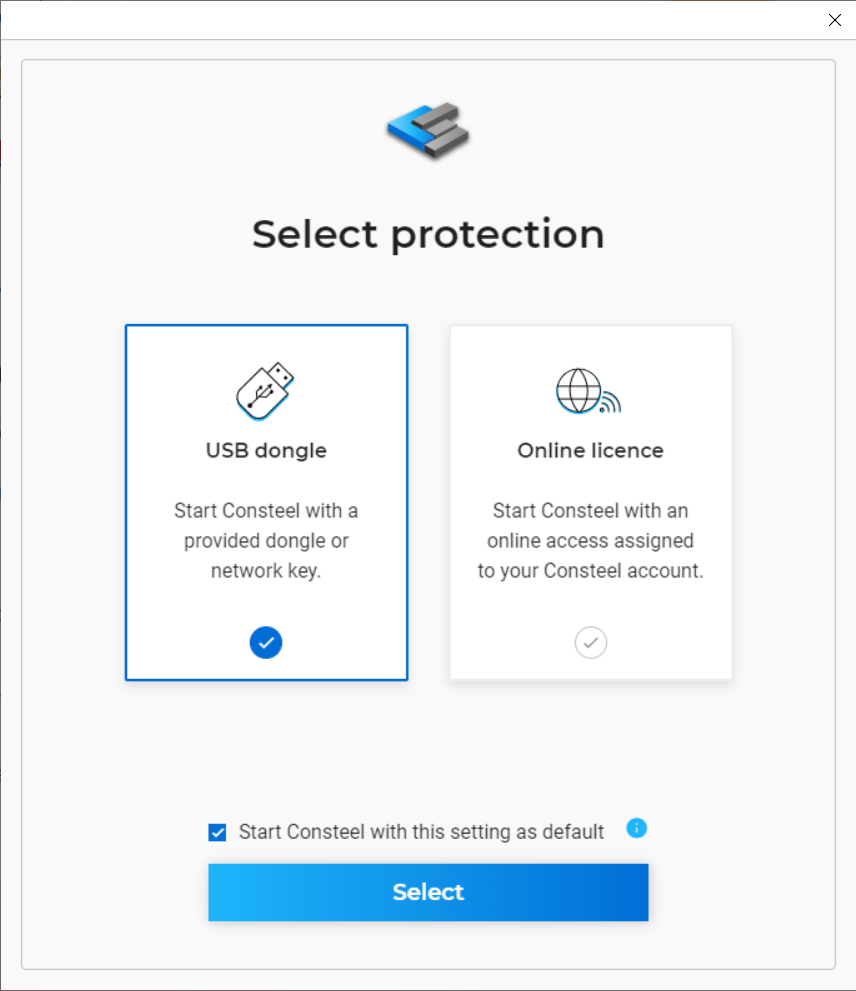
Online szolgáltatások elérhetősége
Mostantól minden felhasználónk számára elérhetővé váltak a Consteel 15 online szolgáltatásként a felhőbe történő modelltárolás és megosztás, valamint a Script könyvtárból elérhető Descript kódok használata. Az új előfizetési rendszer bevezetéséig minden szoftverhozzáféréssel rendelkező felhasználónk Pro szintnek megfelelő Consteel Felhasználói Közösségi tagsággal éri el ezeket a szolgáltatásokat.
USB kulcs védelemmel rendelkező felhasználóinknak elég csak bejelentkezniük a weboldalunkon létrehozott belépési adatokkal. A bejelentkezés történhet a Projekt központon keresztül az „Open from Cloud” gomb nyomásakor, mentéskor a „Fájl/Mentés másként” lehetőségnél a „Cloud” opció választásakor, vagy Descript felületén, hogy elérhessék a szolgáltatásokat a szoftveren belül.
Egy hosszú és intenzív fejlesztési időszak után örömmel jelentjük be, hogy megjelent a Consteel 15!
Az új fejlesztésekkel igyekeztünk követni a legmodernebb trendeket mind a szoftver és szerkezettervezés területén, ideértve a felhőszolgáltatások bevezetését, az API alapú szkriptelési és paraméterezési lehetőségeket, a magasabb szintű mechanikai számítási lehetőségeket egyszerű modellkezeléssel, és még sok mást. Így az új verzióban megvalósítottunk egyedi, komoly áttörést jelentő fejlesztést, valamint számos hasznos javítást és kiegészítést, amelyek hatékonyabbá és kényelmesebbé teszik a Consteel szoftverrel végzett munkát. Szánjunk egy kis időt az alábbiakban felsorolt legfontosabb újdonságok böngészésére, és ismerkedjünk meg a Consteel új verziójával!
Mik a Consteel 15 újdonságai?
Superbeam
A Consteel kibővítette a hagyományos rúdelemek fogalmát a Superbeam koncepció bevezetésével, mely lehetővé teszi az egyidejű analízist kétféle, konzisztensen generált végeselem modellen (rúd és héj). A rúdszerkezet modellezése a Consteel 15-ben továbbra is a hagyományos 1D rúdelemekkel történik, azonban bármely rúdelem esetében lehetőség van egy egyszerű kapcsoló segítségével váltani a hagyományos 7-szabadságfokú rúd, vagy a héj végeselem használata között. Ezáltal lehetővé válik egyes szerkezeti részek alaposabb vizsgálata a 2D héjmodell pontosságával, megtartva az 1D rúdelemek kínálta egyszerű modellezés és módosítás lehetőségét. Fontos megjegyezni, hogy ez a végeselem modell váltás teljesen automatikusan történik, és bármikor visszafordítható.
A rúdelemek kibővített modellezése lehetővé teszi olyan részletek beépítését is a modellbe, mint a gerinc kivágások és merevítők. Az elhelyezett részlet elemek szintén automatikusan konvertálódnak át héj elemekké, és vesznek részt a feszültség és kihajlás analízisben.
Háromféle merevítő elhelyezésére van lehetőség:
- merőleges lemez
- merőleges profil
- párhuzamos lemez
A kivágások, melyek elhelyezhetők a gerinc tetszőleges pontján, szintén háromféle alakúak lehetnek:
- kör
- négyszög
- hatszög
(Megj.: a héj végeselemként számolt elemek nem veszenek részt a méretezésben, hasonlóan bármely más, eredetileg is felületelemként létre hozott szerkezeti elem sem. Az ilyen elemekere továbbra is csak feszültség- és kihajlásanalízis futtatható.)
Projekt Központ
Az új Projekt Központ egyesít mostantól minden, Consteel projektekkel kapcsolatos menedzsment feladatot egy helyen, kiegészítve a személyre szabott információkhoz és tananyagokhoz való könnyű hozzáféréssel. Innen létrehozhatók új modellek, könnyedén hozzáférhetők a legutóbb megnyitott fájlok vagy megnyithatók a számítógépen vagy a felhőtárhelyen tárolt modellek. A legutóbb megnyitott modellek keresését automatikusan generált előnézeti képek könnyítik, amelyek mindig a modellek legutoljára mentett állapotát mutatják. A felhőben lévő modellek megoszthatók más Consteel felhasználóval többszintű jogosultság beállítással, biztosítva a teljes hozzáférést – megtekintés, mentés másként és modellen történő műveletek vagy számítások végrehajtása – vagy csak megtekintési hozzáférést lehetővé téve. A licencinformációkban meg lehet tekinteni az aktuálisan használt licenc részleteit, meg lehet adni a szoftvervédelmi és szoftverindítási preferenciákat, illetve ki lehet kölcsönözni az online védelmű licencet egy előre meghatározott időtartamra offline használatra. Az új Info Hub területen személyre szabott információk jelennek meg, kiemelve a híreket, közelgő eseményeket, szoftverfrissítéseket, fejlesztési részleteket, blog cikkeket vagy tananyagokat. Az oktatóközpont változatos anyagokat és példamodelleket kínál a Tudásbázis anyagaiból a Consteel használati tudás elmélyítéséhez.
Online szolgáltatásokBeta
Nincs szükség többé a fájlok email-en vagy adathordozón történő küldözgetésére. A Consteel modell- és eredmény fájlok már a felhőben is tárolhatók és egyszerűen megoszthatók másokkal, sokkal könnyebbé téve az együttműködést.
A felhőbe történő mentés a Steelspace platform keresztül történik, biztosítva az egyszerű tárolást, megosztást és hozzászólási lehetőséget a modellek számára. Az új, felhőalapú mentési és megnyitási lehetőségekkel a modellek úgy kezelhetők, mintha a személyes felhőtárhely az asztalon lenne. Ebbe a tárhelybe mentett modellek könnyen és gyorsan áttekinthetők, megnyithatók és megoszthatók akár közvetlenül a Consteel felületéről is. Megosztás során lehetőség van a hozzáférési jogosultságok kontrollálására is, biztosítva a megosztott modellhez való teljes hozzáférést, vagy egy korlátozottabb elérhetőséget.
Service center
Ebben az online térben gyűjtjük össze és osztjuk meg felhasználóinkkal a szerkezettervezés és -méretezés, valamint az építőipari újdonságok terén szerzett tudásunkat és tapasztalatainkat.
Felhasználói kézikönyvek: részletes leírások a Consteel és a Descript funkcióiról új, online formában, az egyes a témák és cikkek közötti egyszerű navigációval. Ezenkívül könnyű keresést, részletes használati útmutatókat és visszajelzési lehetőséget is biztosít a felhasználóknak.
Tudásbázis: különböző típusú és nehézségű tananyagok és modellek gyűjteménye, mely segít hatékonyabbá tenni a Consteelben végzett tervezési munkafolyamatot. Tartalmaz útmutatókat a Consteellel való ismerkedéshez, bevált módszerekhez tippeket-trükköket, példamodelleket a funkciók kipróbálásához, mélyreható használati útmutatókat mind az elmélettel, mind a gyakorlati alkalmazással kapcsolatban egy-egy speciálisabb Consteel megoldás mélyebb megismeréséhez, és még sok mást is.
Script könyvtár: teljeskörű válogatás többszintű script megoldásokból. Széles választékot tartalmaz előre megírt, azonnal felhasználható Descript példakódokat a Consteel munkafolyamatok felgyorsítására. Ezenkívül több Grasshopperben futtatható scriptet is tartalmaz a parametrikus tervezés és Pangolin bővítmény használat legjobb megoldásaival. A haladó felhasználók számára lehetőség nyílik a Consteel API erejének kihasználásra különböző scriptek segítségével.
A Service Center egyes anyagaihoz való hozzáférés a felhasználó Consteel Felhasználói Közösség tagsági szintjétől függ.
Online védelem és licenc menedzsment
Mostantól már minden felhasználónk számára elérhetővé válik az megújított és kibővített online szoftvervédelmi rendszer legyél diák, egyéni szakember vagy tervező irodai csapat tagja.
Az online licenc menedzsment felület kényelmes kezelést biztosít a Consteel előfizetési csomagjaihoz és a Consteel Felhasználói Közösség tagsági rendszerhez kapcsolódó összes szükséges szolgáltatáshoz. A szolgáltatás kezelése a Consteel integrált része lett, így bármikor ellenőrizheti a licenc aktuális állapotát a Consteelen belül vagy a weboldalunkon a személyes fiókban.
Csapat előfizetési csomagot használó ügyfeleink egy új, online licenckezelő eszköz segítségével szabályozhatják a szoftver helyek és hozzáférések kiosztását az egyes felhasználók számára, sokkal rugalmasabbá téve a szoftver hatékony használatát a vállalaton belül.
Consteel API
Az API az Application Programming Interface kifejezés rövidítése, egy szoftver kapcsolat, amely lehetővé teszi, hogy két alkalmazás kommunikálhasson egymással.
Miért hasznos ez a szerkezettervezésben?
Az API olyan műveleteket támogat, mint például a keresztmetszetek, szerkezeti elemek, támaszok, kapcsolati elemek, terhek és sok más típusú modellobjektum kiolvasása a modellből, illetve mindezek létrehozása. Az API képes modellfájlok olvasására és írására egy futó Consteel programmal kommunikálva, így lehetővé téve a felhasználók számára, hogy a Consteel grafikus felhasználói felülete helyett saját programjukon keresztül lépjenek kapcsolatba a Consteel modellel, időt spórolva összetett és hosszadalmas műveletek elvégzésekor.
Ha szeretne többet tudni a Consteel API-ban rejlő lehetőségekről, ne habozzon kapcsolatba lépni velünk.
Descript programozási felület
A Consteel saját, megújított programozási nyelve és egyedi programozási felülete közvetelnül a Consteelbe integráltan a munkafolyamatok felgyorsítására.
A Descript nyelvet (korábbi elnevezése csPI) a szerkezetmérnökök igényei szerint terveztük, hogy egy hatékony eszközt biztosítsunk modellek, modell objektumok és az azokon végzett műveletek és számítások rugalmas létrehozásához, kezeléséhez és futtatásához. Lehetővé teszi olyan unalmas vagy nehéz feladatok automatizálását, amelyekhez nem létezik kész megoldás a programban, a Descript eszközkészletével azonban elvégezhetők. A MyDescript felület, a Consteel személyes programfájl-kezelője lehetőséget ad saját Descript fájlok létrehozására vagy betöltésére, valamint az online fiókon keresztül hozzáférést biztosít a Script Tár tartalmaihoz is. Egy részletes online kézikönyv is rendelkezésre áll, amely segíti a Descript használatának elsajátítását.
Pangolin 2.0
A Pangolin plugin integrálja a Consteel szerkezet modellezését és analízisét a Rhino/Grasshopper parametrikus környezetébe.
A Pangolin beépülő modul lehetővé teszi, hogy a Grasshopperben a paraméteres geometriai modellt szelvényekkel, támaszokkal, terhekkel és minden, a Consteelben elérhető tulajdonsággal és funkcióval felruházva, közvetlenül Consteel modellt lehessen létrehozni. Ez a modell ezután feltölthető a felhőbe a Steelspace-en keresztül, vagy akár közvetlenül a Consteelbe is. A Grasshopper és a Consteel élő kapcsolata azt is lehetővé teszi, hogy a Consteelben épített modellt Grasshopperben további elemekkel és terhelésekkel egészítsük ki, természetesen szintén parametrikusan.
Az új, 2.0-s verzió a következőket tartalmazza:
Az első és másodrendű számítás valamint a globális tervezés (méretezés) eredményeinek visszatöltése a Grasshopper modellbe. A beolvasott adatok tartalmazzák az igénybevételeket, kihajlási sajátértékeket, alakváltozásokat, a deformált alakot, beleértve a kihajlási alakokat is. A méretezési eredmények magukban foglalják a mértékadó eredményeket, az azokat eredményező teherkombinációval együtt, valamint az összes részeredményt minden ellenőrzött végeselemre.
Töltsd le a Pangolint innen, és próbáld ki ingyen. (Rhino-Grasshopper szoftver szükséges hozzá)
SAF modellek megnyitása
Új fájlformátummal bővült a Consteel által olvasható formátumok sora. Ez a SAF (Structural Analysis Format), a Nemetschek Group által fejlesztett, Excel alapú, nyílt adatcsere formátum, melyet már jelenleg is sok más mérnöki- és építész szoftver támogat. Ennek az új kezdeményezésnek a célja, hogy javítsa egyrészt a szerkezettervező mérnökök, másrészt a különböző szakágak közötti együttműködést egy olyan nyílt formátum kifejlesztése által, mely lehetővé teszi a statikai váz geometriai és teher adatainak cseréjét FEA és CAD programok között.
A Consteel 15-tel, a mérnökök immár képesek megnyitni SAF formátumban (a fájlok .xlsx kiterjesztésűek ebben a formátumban) exportált szerkezeti modelleket, melyek közvetlenül Consteel modellé konvertálódnak a folyamat során.
Szelvények szerint színezett modell
A szerkezeti modell megjelenítésében megjelent egy új lehetőség: a szelvények szerint színezett modell ábrázolás. A Consteel 15-ben minden szelvény, a szelvénybetöltés során, automatikusan kap egy egyedi színt, mely később természetesen megváltoztatható. Régebbi modellek megnyitása esetén is megtörténik a színek hozzárendelése. Az állapotsor jobb oldalára került egy új kapcsoló, mellyel váltani lehet az alapértelmezett és a szelvények szerinti színezés között.
Informatívabb eredménymegjelenítés
Az eredmények minél könnyebb értelmezését és látványosabb megjelenítését nyújtják legújabb vizualizációs fejlesztéseink.
Térbeli feszültségdiagramm
A szelvény modulban a feszültségdiagrammok már egy új, térbeli ábrázolásmódan is megjeleníthetők, ezzel segítve a szelvény feszültségállapotának jobb megértését.
Simított és valósághű deformációs ábrák
A Consteel 15-ben a szerkezet valós 3D-s viselkedése jobban látható a deformációk megjelenítésében történt fejlesztéseinknek köszönhetően. Az új verzióban már nem a végeselemek elmozdulását és tengely körüli elcsavarodását ábrázoljuk, hanem a keresztmetszet minden kitüntetett pontjának a tényleges eltolódásait, beleértve a hetedik szabadságfokból adódó szelvény torzulás hatását is. Mindez folytonos, érthetőbb és szebb, valamint a lemezmodellel megegyező deformációs ábrákat eredményez rudak esetén is.
Színezett igénybevételi ábrák
Az igénybevételi és elmozdulási ábrák megjelenítésében új lehetőség a színezett diagrammok megjelenése. A negavtív értékek kékkel, a pozitív értékek pirossal jelennek meg, jobb érthetőséget biztosítva az eredmények áttekintése során.
Kihajlásérzékenység ábrák
A kihajlásérzékenységi vizsgálat eredményeinek jobb megértését segíti az, hogy azok mostantól a valós kihajlási alakokon láthatók. A kritikus elemeken így azonnal látható az is, hogy milyen kihajlási mód okozta azt.
További kiegészítő fejlesztések
Terhek sokszorosítása új teheresetekbe
Változó helyzetű terhek (mozgó terhek) könnyebb létrehozását segíti a másolás funkcióban megjelent új lehetőség, mellyel a kijelölt terhek másolása már nemcsak a saját teheresetén belül történhet, hanem új teheresetekbe is. Utóbbi esetben a teher minden másolata az adott tehercsoporton belül automatikusan létrejövő új teheresetbe kerül.
Kényszer elemek
A Superbeam koncepcióhoz kapcsolódóan került bevezetésre a Consteelben a kényszer elem is. Ezek az elemek jelenleg kézzel nem hozhatók létre, csak az alábbi funkciók által jöhetnek automatikusan létre, és a végeselemes modellben megjeleníthetők:
- keretsarok: a kényszer elem korábban is létezett, de a felhasználó számára nem látható módon.
- rúd elem héj végeselemes számítási modellre történő átállítása esetén a héj-rúd átmenet definiálására kerülnek elhelyezésére a kényszer elemek.
Rúdvégi folytonosság (csukló) megújítása
A rúdvégi folytonosságok (csuklók) modellezését is megújítottuk egy új, nulla hosszúságú folytonosság-végeselem bevezetésével. A rúdvégi folytonosságok kezelése kikerül a rúd végeselemből, és átkerül egy új elembe, mely a rúdvég és a csatlakozó szerkezeti elemek között helyezkedik el. Ez semmilyen változással nem jár a felhasználó számára a modellezés során, minden automatikusan történik a végeselemes modell előállítása során. Azonban ebből a módosításból, melyre az alakváltozások valósághűbb ábrázolása miatt volt szükség (ld. feljebb) következik néhány, a felhasználók számára is jól látható és pozitív változás:
- Mostantól már hosszváltozást okozó teher (hőmérséklet, tűz, feszítés) is elhelyezhető olyan elemen, melynek tengelyirányú rúdvégi elmozdulása feloldott.
- A csomópontba befutó, eltérő rúdvégi folytonossággal ellátott rudak eltérő rúdvégi elmozdulásainak valósághű megjelenítése
Láthatósági kapcsolók bővítése
Bővítettük a modell objektumok megjelenítését szabályozó láthatósági kapcsolók számát. Az új, kibővített beállító ablakba 6 új kapcsoló került, így most már szabályozható valamennyi szerkezeti objektum láthatósága. Az új kapcsolók a következők:
- kényszer elem (új objektum)
- merev test
- diafragma
- szelemensor
- merevítő (új objektum)
- kivágás (új objektum)
Teherátadó felületek továbbfejlesztése
A teherátadó felületek teher szétosztást szabályozó algoritmusát továbbfejlesztettük, hogy minél kevesebb, általában modellezési pontatlanságból fakadó hibaüzenettel találkozzon a mérnök napi munkája során.
Ennek eredményeképpen olyan modelleken is kevesebb problémával találkozhatunk, melyeket más programokból importáltunk a Consteelbe, és gyakran tartalmaznak apró pontatlanságokat, mely pontatlanságok a végeselemes modellben hibát okozhattak.
Part 2 – Supplementary services
Goal of the supplementary services
Serving the clients does not end with developing a good software product for them. This is especially true for structural analysis and design software for two main reasons:
- these products cover quite wide and complex engineering workflows from model building with realistic mechanical conditions (supports, connectivity, loads, etc.) through structural analysis to documented standard design checks;
- the inappropriate use of these complex tools can result in unsafe solutions with very serious consequences which are generally the responsibility of the end-users.
Accordingly, from the end user’s point of view, the main goal of the supplementary services is to make their work with the software safe and efficient. These aspects are usually conflicting and fulfilling them requires a solid knowledge not only in the general structural mechanics and standard design methods but in the software-specific solutions as well which are typically not evident.
Learning and maintaining the proper use of structural analysis and design software requires considerable time from the user and a considerable amount of services from the software vendor. However, it is certainly worth investing in this on both sides since it immediately pays off in more effective and faster lead-time design projects. On the other hand, the longer and deeper learning of the proper use of the software (so the more invested time and energy in to be a professional in a specific software product) strengthen the engagement of the users which is the primary goal of the software producers. In the following section, it is presented how we want to implement and manage these services and how we think about user engagement.
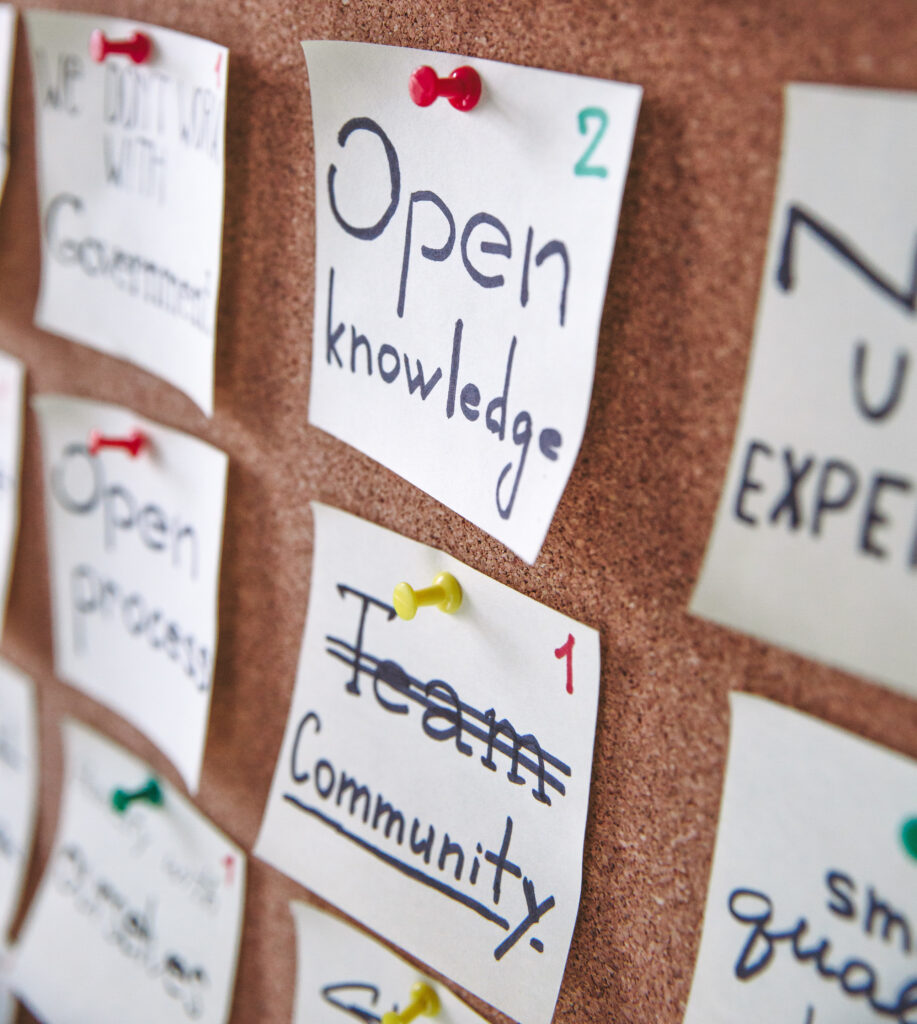
Consteel Community Membership
At Consteel we strongly believe in the power of the community which in our case means that if we – software developers and end-users – agree on our common values and goals and share our talents and knowledge then we, together could be much more successful than individually.
Accordingly, we think that our connection to our customers should not be a one-way channel but a two-way, engaged relationship where we share our best knowledge in the form of modern software and supplementary services and our customers’ response to us by their practical expertise in the form of opinions, needs, workflows, projects, etc. This relationship is more than a simple subscription to software, it is already a membership organization.
According to Wikipedia the membership organizations “… typically have a particular purpose, which involves connecting people around a particular profession, industry, activity, interest, mission or geographical location. This might simply be to encourage or facilitate interaction and collaboration, but it also often involves promoting and enhancing the purpose itself.” And this is exactly what we want – and also this is part of our mission statement:
“We want to support a new generation of user community where the governing working rules are collaboration and knowledge sharing. Our dream is to connect demands and solutions, users and developers, models and calculations from all over the world to help a truly efficient design workflow utilizing the power of the engineering community.”
So we change our previous system for the support, maintenance, and upgrades and collect our supplementary services into a multilevel Consteel Community Membership system. In close accordance with our new licensing system where we would provide the software license only for users subscribed to the access of the newest version (no permanent license without a subscription), we aim to form a community of engaged users with the kind of behavior described above, because we think that this can be much more efficient than a simple subscription system.
Community engagement has different levels from the passive, one-way information flow type relationship through the bridge-building, reactive type involvement until the fully integrative and cooperative engagement. The latter one is the most desirable transformational and game-changing way of collaboration and we want to have our users step up from the lower levels to this one within the Consteel Community Membership. So we have implemented the environment and tools for our supplementary services to be able to support this vision, it will be presented a little bit more in detail in the next section.
Provided services
There are a couple of factors influencing the user’s satisfaction and engagements, the most important ones are the followings:
There are a couple of factors influencing the user’s satisfaction and engagements, the most important ones are the following:
- Software quality, updates
- Flexible licensing
- Level and quality of support
- Supplementary services
- Usual classic services:
- Learning materials
- Trainings
- Events (user days, competitions, etc.)
- Feedback channels (surveys, fast feedback systems, etc.)
- Advanced services from Consteel
- Cloud services
- Scripting
- Usual classic services:
Most of the above list does not need any explanation, but some key features of them connected to community building are worth discussing. First, a general point is presented regarding the availability of the services, and then the background, aims and some content of the two special services – cloud and scripting – introduced this year will be explained.
Important to note that we are fully dedicated to developing further the services not only by continuously increasing the contents but by widening the ways and channels to shape our community engagement.
Exclusivity of services
An important feature of good membership organizations or communities is that members feel privileged to belong to that community. This privileged status can be efficiently strengthened by making the valuable services available exclusively to the members. Also, it is a well-known fact that people value much more what they pay for.
Customers tend to forget or postpone activities in services offered for free – a typical example is a participation in free webinars, which is generally a fraction only of the number of applicants. They feel more directly the value of – and accordingly they are more active in – paid services which in turn highly increase their engagement and their community participation. It is also important to see that the production and promotion of these services are costly activities usually requiring our best experts and this is basically covered by the payments of our users.
Since it is our primary goal to increase the community engagement of our users, we will reserve our most valuable services exclusively to the members of our membership organization and will not make them available freely for everybody like it is now usual. Some of these services – mainly the classic learning materials – will be available in our new Service Center, but several other types are planned to complement the software features.

Cloud services
With our brand-new cloud services, we want our customers to move outside of their computers and have them be more open to using online services. We see a huge potential in the cloud services and accordingly invest more and more into it, placing special features here, which are thought to be much more efficient to use in that way than as an in-built desktop software functionality.
On the other hand, we think (and hope) that the use of cloud services supports the culture of sharing and feedback within the structural design workflows which we see as a quite rare and far not universal characteristic of today’s structural engineering communities (unlike the software developers’ communities where it is a very general feature). So our unconcealed goal with the cloud services is to help our users to step ahead in the development of community engagement.
In the first phase, we will provide a very easy way of cloud save, store and open complete Consteel models together with a comprehensive opportunity for sharing them with colleagues either in the cloud or even in Consteel. The users can conveniently access their models from the office computer, from the home laptop, or from practically anywhere and from any device using their online protected software. The structured, cloud-stored, and properly access-managed shared models can be the basis of a real collaborative workflow in a design project, in an engineering office, or even in a university course.

Scripting services
Scripting techniques are a very progressive and efficient way to control and manage model creation, modification, and calculations. Last year we presented our Grasshopper plugin, Pangolin, opening the way for Grasshopper users to build a complete, parametric Consteel model ready to analyze and design. But before that, a few years ago, we had introduced in Consteel a unique, in-built scripting tool with an internal programming environment. Our intention with this development was to offer an introductory scripting tool directly for structural engineers not fully familiar with these techniques and this is what we call now Descript.
To make it convenient to use for the structural engineers working in Consteel principally, Descript has been developed as a programming language following closely in its logics and syntaxes the structure of the Consteel objects with their attributes, and the operations. Also, the programming environment is placed inside the UI of Consteel so there is no need for any external code development environment. This environment is now completely reworked and supplemented with several supporting services making it even more transparent and easy to use.
The scripting workflow in Descript will be supported by a new, comprehensive manual with several simple code examples. In the brand new Script Library, continuously growing number of Descript codes are collected providing useful supplementary functionalities at different levels of complexity. The most important novelty is the MyDescript interface in Consteel, where all the codes in the Script Library can be accessed, executed, or saved, and further modified or developed according to the level of membership of the user.
These services are designed to get our users to start working with scripting techniques to make their workflows more standardized, thoughtful, and efficient. As a future perspective, we plan here also to exploit the power of the community by providing a place for the members of the Consteel Community to share, comment, rate, and improve the Descript codes of each other.
We are really excited to let you know that Steelspace has launched! We believe that cloud-based services are the future! Our colleague had already written a great post about how cloud services can accelerate our workflow. We think structural design experience could be so much more if we take advantage of the opportunities of the cloud.
Just a few of the many benefits of moving services and data to the cloud:
- the user saves time and resources,
- their work is more secure,
- and collaboration between multiple users is much smoother and easier
We are confident that engineering work is facing a similar transformation and we want to be one of the inducers of this process with our latest development.

What is Steelspace?
Steelspace is a cloud-based storing, sharing and service providing open platform for structural models and their analysis or design results.
Users are immediately able to upload, store and view structural models from Grasshopper Pangolin and from Consteel and share them with colleagues having also Steelspace account. On the models in Steelspace several structural analysis and design calculation packages can be executed which are available for and compatible with the uploaded model.
Not sure how to export your model to Steelspace? Check our quick guides on Youtube!
The system is still under development and we will make sure to continuously improve our services. If you interested, head to Steelspace.io and give it a try! You can log in with your Consteel account if you already have one or just register for free.
We are open to collaborations as well! If you have a great idea or solution to implenet in Steelspace, don’t hesitate to contact us!
Steelspace
